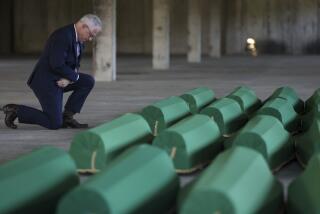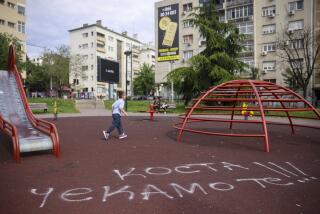Two Years On, a Bosnian Wife Learns She’s a Widow
- Share via
BANOVICI, Bosnia-Herzegovina — The last time Dzemala Vilic saw her husband, during the chaotic fall of Srebrenica, she begged Bosnian Serb soldiers to spare his life.
“He’s an old man,” she implored. But he was led away with thousands of other Muslim men on that summer day in 1995. Only now has Vilic learned, officially and formally, of his fate.
The body of Nazif Vilic, 70, was exhumed from a mass grave in eastern Bosnia-Herzegovina last year, and this week his remains were positively identified following a laborious investigation involving autopsies, lengthy interviews and sophisticated DNA testing.
Nazif Vilic and two other men are the first victims of the Srebrenica massacre to be identified, more than two years after the Muslim enclave was captured by the Bosnian Serb army and an estimated 7,500 men and boys disappeared.
With 40 or so more identifications to be made by year’s end, the news is finally allowing a tiny number of Muslim families to come to terms with their loss in the Bosnian war’s worst atrocity.
“There was so much killing, we really had no reason to hope,” Dzemala Vilic said Friday, the day after she was formally notified. She sat in a bare brick house in this isolated coal-mining town, where she lives as a refugee with her daughter, two grandchildren and other survivors of Srebrenica.
The identifications are primarily the work of the Boston-based Physicians for Human Rights, an advocacy group that has spent the past year collecting information from surviving families on their missing relatives--what they were wearing, distinctive physical characteristics such as bone breaks or wounds, tattoos and so forth. The details were entered into a computerized databank and checked against information emerging from autopsies on many of the approximately 700 bodies exhumed last year from six mass graves believed to contain Srebrenica victims.
Only about 40 solid leads resulted. The remains that would be identified as Nazif Vilic were particularly promising. He carried three pairs of eyeglasses, pills, a wallet with photographs, a comb and a written message to his son.
Eventually, the Vilic family was shown photographs of muddy clothing recovered with the body. Immediately, Dzemala recognized the shoelaces she had crafted for her husband from parachute cords.
The message, addressed to a son living in neighboring Croatia and never delivered, seemed to be Nazif speaking from the grave. In it he reports the death of a son-in-law: “We are all right and together in Srebrenica. Please do not be surprised: Enver is dead. A shell killed him. We have enough food. We did not suffer too much. Everything is burned.”
The clothing and the message were proof enough for the Vilic family. But the forensic specialists working on the project said that because documents and even clothing could have been exchanged by the panicked victims, more precise science was necessary.
DNA tests using blood from surviving relatives and the teeth of the dead were conducted in a Seattle laboratory, said Laurie Vollen, head of the identification project.
Despite the certainty that such testing offers, many of the Srebrenica women are impatient and cannot understand why identification takes so long. A large number of them cling to a desperate hope that their men are still alive. Some are convinced that their husbands and sons are being held as forced laborers in the Serb-controlled half of Bosnia. Officials with the International Committee of the Red Cross are skeptical.
*
Vollen and others say only a small fraction of victims will ever be identified. The Srebrenica disaster is complicated by the lack of medical and dental records--few were kept, and those that were have since been destroyed by the Serbs. In addition, the Srebrenica men were taken to various locations to be killed, meaning people from different villages and neighborhoods were mixed together.
And many people living in Srebrenica were already refugees, having fled there from other areas after the town was declared a haven by the United Nations in 1993.
That was true of the Vilic family. Dzemala figures she lost 60 members of her family in Bosnia’s 43-month war, which ended five months after Srebrenica fell--including her mother and sister, two brothers and the five sons of one of the brothers.
Nazif Vilic was pulled with about 130 other bodies from a grave in a field at Pilice, a hamlet about 40 miles north of Srebrenica where Muslim men were believed to have been taken by bus, then lined up and shot. A young soldier with the Bosnian Serb army confessed to the international war crimes tribunal at The Hague that he had participated in the murder of hundreds of unarmed Muslims at Pilice.
Some of the exhumed bodies had their hands tied behind their backs. Evidence from the exhumations is being used to build cases against Bosnian Serb leader Radovan Karadzic and his former military commander, Gen. Ratko Mladic. The latter directed the Srebrenica takeover, and the two men have been indicted on genocide charges related to Srebrenica.
As bodies are exhumed, a dispute is emerging over where to bury the remains. Politicians who have been quick to manipulate the Srebrenica survivors want to press for burial in Srebrenica, which remains under Bosnian Serb control. Dzemala Vilic said the place is not as important to her as burying the victims together.
“They left Srebrenica together,” she said. “They should stay together.”
More to Read
Sign up for Essential California
The most important California stories and recommendations in your inbox every morning.
You may occasionally receive promotional content from the Los Angeles Times.














